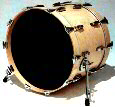 As an amateur recording engineer, you’ll likely run into the name Recorderman when learning how to mic a drum kit. Recorderman’s approach to placing overhead drum microphones is recommended for beginners because it’s easy to set up, and yields good, sometimes great, results in practically every situation.
As an amateur recording engineer, you’ll likely run into the name Recorderman when learning how to mic a drum kit. Recorderman’s approach to placing overhead drum microphones is recommended for beginners because it’s easy to set up, and yields good, sometimes great, results in practically every situation.
The name “Recorderman” comes from a user on the recording.org forums who is credited with popularizing the technique. (Though his approach has been used by engineers for decades. It’s largely a two-mic adaptation of Glyn Johns’ mic setup.)
Here’s Recorderman’s original post about his technique, along with some good followup discussion. And this Gearslutz thread on overhead drum mic placement has more discussion and pictures.
Recorderman in a nutshell: Use two drum sticks as a ruler to place your mics the same distance from the snare drum, and a cable or string to get them equidistant from the kick beater. Here’s the best video description I’ve seen, to better illustrate:
Recorderman’s approach accomplishes 3 things:
- It places the snare and kick drums in the center of the stereo image.
- It ensures any close mics on the kick and snare are in phase with the overheads.
- It captures a balanced drum kit sound, close to what the drummer hears.
This microphone setup is ideal in a few situations:
When you have limited microphones for the drums: Especially when you only have 2 or 3 mics, Recorderman can still get you an open, balanced stereo image of the drum kit. If you’re recording a talented drummer, 2 or 3 microphones in this arrangement might be all you need.
Recording with low ceilings or in a tight space: Drums sound best in a big, open room. Traditional overhead miking approaches tend to capture a “smeared” drum sound when used in small rooms, largely because sound reflections off the ceiling interfere with the direct sound from the drums. Recorderman’s technique gets the microphones close enough to the drums that this isn’t an issue.
When the drums sound killer at the drummer’s position: With decent microphones, this setup usually captures a sound close what the drummer hears. If the drums sound ideal right where the drummer is sitting, you should consider a Recorderman setup even if you’re in a high-ceilinged space.
(Note: I use a modified version of Recorderman for The Morning Rain drum tracks. There are a few pictures, and sound samples here.)
Previously: Better drum mixes with a drum reference track, Parallel compression for fatter drum tones
For more home recording tips,
Subscribe to the Hometracked feed, or receive email updates.

35 comments
Trackback URI Comments feed for this article
question about people who use the AT2020 condensor mic’s.
(please forgive me…i’m not a drummer but want to record my kid’s band).
anyway..when you use the AT2020 mic’s in the recorderman fashion….do you “POINT” the mic at the drums…like…point at it?
or
do you make it so the long sides of the microphones are pointing at the drums?
know what i mean?
when i see people using the AT2020’s..they’re always talking into the side of the microphone…like it’s pointed in the air and they’re talking in the side?
is there a right way/wrong way for these mics to be used?
hope you know what i’m asking.
thanks.
That is a side address microphone which means the side (“long part”) is where the sound you want captured is meant to be aimed. Also, having a cardiod pickup pattern, as this mic does, means there’s a front and back to the sides. Find the front, point noise at that.
The Recorderman is the best overhead method I’ve tried. It’s almost fail proof. I still usually end up having to switch the polarity of my kick drum, but that is quite alright. That’s an easy enough fix in the DAW.
This is really future helpful information .
More Comments: ‹ Previous · 1 · 2